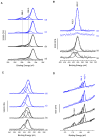Engineering of Antimicrobial Surfaces by Using Temporin Analogs to Tune the Biocidal/antiadhesive Effect
- PMID: 30813478
- PMCID: PMC6412374
- DOI: 10.3390/molecules24040814
Engineering of Antimicrobial Surfaces by Using Temporin Analogs to Tune the Biocidal/antiadhesive Effect
Abstract
Proliferation of resistant bacteria on biomaterials is a major problem leading to nosocomial infections. Due to their broad-spectrum activity and their ability to disrupt bacterial membranes through a rapid membranolytic mechanism, antimicrobial peptides (AMPs) are less susceptible to the development of bacterial resistance and therefore represent good candidates for surface coating strategies to prevent biofilm formation. In this study, we report on the covalent immobilization of temporin-SHa, a small hydrophobic and low cationic antimicrobial peptide exhibiting broad-spectrum activity, and (SHa) analogs on modified gold surfaces. Several analogs derived from SHa with either a carboxamidated ([K³]SHa, d-[K³]SHa) or a carboxylated C-terminus ([K³]SHa-COOH) were used to achieve peptide grafting on gold surfaces modified by a thiolated self-assembled monolayer (SAM). Surface functionalization was characterized by polarization modulation infrared reflection absorption spectroscopy (PM-RAIRS) and X-ray photoemission spectroscopy (XPS). The antibacterial properties of the temporin-functionalized surfaces were tested against the Gram-positive Listeria ivanovii. Direct visualization of the peptide effects on the bacterial membrane was investigated by scanning electron microscopy equipped with a field emission gun (SEM-FEG). All active temporin analogs were successfully grafted and display significant antibacterial activity (from 80 to 90% killing efficiency) in addition to a 2-fold decrease of bacterial adhesion when all d-SHa analogs were used.
Keywords: SHa analogs; antibacterial/antiadhesive activity; antimicrobial peptides; gold surface functionalization; temporin-SHa.
Conflict of interest statement
The authors declare no conflict of interest.
Figures






Similar articles
-
Temporin-SHa peptides grafted on gold surfaces display antibacterial activity.J Pept Sci. 2014 Jul;20(7):563-9. doi: 10.1002/psc.2654. Epub 2014 Jun 12. J Pept Sci. 2014. PMID: 24919960
-
Insight into the mechanism of action of temporin-SHa, a new broad-spectrum antiparasitic and antibacterial agent.PLoS One. 2017 Mar 20;12(3):e0174024. doi: 10.1371/journal.pone.0174024. eCollection 2017. PLoS One. 2017. PMID: 28319176 Free PMC article.
-
The antibacterial activity of Magainin I immobilized onto mixed thiols Self-Assembled Monolayers.Biomaterials. 2009 Jul;30(21):3503-12. doi: 10.1016/j.biomaterials.2009.03.025. Epub 2009 Apr 5. Biomaterials. 2009. PMID: 19345992
-
Antimicrobial peptides as potential anti-biofilm agents against multidrug-resistant bacteria.J Microbiol Immunol Infect. 2017 Aug;50(4):405-410. doi: 10.1016/j.jmii.2016.12.005. Epub 2017 Jun 26. J Microbiol Immunol Infect. 2017. PMID: 28690026 Review.
-
AMPs as Anti-biofilm Agents for Human Therapy and Prophylaxis.Adv Exp Med Biol. 2019;1117:257-279. doi: 10.1007/978-981-13-3588-4_14. Adv Exp Med Biol. 2019. PMID: 30980362 Review.
Cited by
-
Temporins: Multifunctional Peptides from Frog Skin.Int J Mol Sci. 2023 Mar 12;24(6):5426. doi: 10.3390/ijms24065426. Int J Mol Sci. 2023. PMID: 36982501 Free PMC article. Review.
-
Synthesis of Second-Generation Analogs of Temporin-SHa Peptide Having Broad-Spectrum Antibacterial and Anticancer Effects.Antibiotics (Basel). 2024 Aug 11;13(8):758. doi: 10.3390/antibiotics13080758. Antibiotics (Basel). 2024. PMID: 39200058 Free PMC article.
-
Temporin-SHa and Its Analogs as Potential Candidates for the Treatment of Helicobacter pylori.Biomolecules. 2019 Oct 11;9(10):598. doi: 10.3390/biom9100598. Biomolecules. 2019. PMID: 31614561 Free PMC article.
-
Designed Multifunctional Peptides for Intracellular Targets.Antibiotics (Basel). 2022 Sep 3;11(9):1196. doi: 10.3390/antibiotics11091196. Antibiotics (Basel). 2022. PMID: 36139975 Free PMC article. Review.
-
Short Ligand, Cysteine-Modified Warnericin RK Antimicrobial Peptides Favor Highly Sensitive Detection of Legionella pneumophila.ACS Omega. 2021 Jan 6;6(2):1299-1308. doi: 10.1021/acsomega.0c04753. eCollection 2021 Jan 19. ACS Omega. 2021. PMID: 33490789 Free PMC article.
References
MeSH terms
Substances
LinkOut - more resources
Full Text Sources

